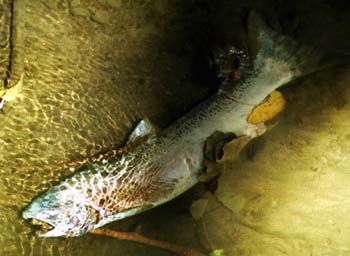![[Metroactive News&Issues]](http://metroactive.com/gifs/news468.gif)
[ San Jose | Metroactive Central | Archives ]
Fish Story
The Chinook salmon finds its way to the Guadalupe River, barely
By Jim Rendon
ROGER CASTILLO has a thing for eating lunch outside. He'd rather watch birds and other animals forage for food along the Guadalupe than bear witness to fellow techies hunting and gathering ham sandwiches in a cafeteria. On one of his streamside lunch breaks in 1986 he noticed something that changed his life. He saw a fish. Not just any fish, but a long and fat silver-pink flash in the water. It was more than 2 feet long. He was convinced it was a salmon.
"People thought I was crazy. My best friend said I was nuts," Castillo says. They were all wrong. Since that day more than 10 years ago, Castillo has become the local expert on San Jose's growing salmon population. He has recorded hundreds of hours of videotape, some of which is up on his website, www.silichip.org. And as more and more salmon return to the Guadalupe to spawn every year, he has forced the city to think about this river as more than a crooked, exposed water pipe.
Less than a century ago, the Bay Area was a spawning ground for a vast salmon population. David Brower, the father of the modern environmental movement, says he can remember a dozen streams in the East Bay that supported the fish when he was a boy, and the rivers and streams of the South Bay system were once thick with the migrating fish.
Chinook salmon live both in the ocean and in fresh water. Every fall, adults in the North Pacific begin heading toward land, some traveling as far as 3,000 miles. They are returning to the stream, and sometimes to the very gravel bed, where they were born. When they reach their freshwater destination, they lay or fertilize eggs, and then die.
Biologists understand little about the fish's remarkable ability to make its way home. Some say the salmon's sense of smell helps guide them back; others say they use the earth's magnetic field.
On his website, Castillo shows videotape of a shining chinook trying again and again to throw itself over a concrete barrier in the Guadalupe. That fish, Castillo says, never made it, going belly up before it could complete its breeding cycle, like thousands of salmon throughout the state. Logging and development along the West Coast have destroyed many of the rivers that salmon need to reproduce. Along with overfishing, these pressures have devastated many salmon populations, landing many of them on the endangered species list.
In San Jose, salmon now have a better chance of successfully laying their eggs. The Santa Clara Valley Water District just unveiled the city's first fish ladder, a stepped concrete structure that makes it easier for salmon to get past man-made barriers. But they still must find the right spot to lay their eggs.
The Guadalupe and its many tributaries are hardly perfect for the fish. In some places homes and businesses have been built to the river's edge. In others the riverbed has been replaced by a concrete channel. Without a buffer of trees and shrubs on the river's edge, the steam erodes, destroying the calm gravel-bottomed pools that the salmon need to lay their eggs in. And without enough sheltering vegetation the water heats up, causing the temperature to get too high for the eggs to hatch.
With sky-high land values, every stream-side buffer is a fight. Castillo has been working with San Jose on its salmon protection plan and hopes that the planning department and city will take it seriously when it becomes policy.
Despite the perils that the salmon face, Castillo loves the wild feeling this massive fish brings to Silicon Valley. "Just the other day I watched an osprey swoop down on a salmon in the river and fly away with it. It landed and was eating the fish right along Route 87," he says with excited satisfaction.
[ San Jose | Metroactive Central | Archives ]
Copyright © 1999 Metro Publishing Inc. Metroactive is affiliated with the Boulevards Network.
For more information about the San Jose/Silicon Valley area, visit sanjose.com.
![]()

Photograph by George Sakkestad
Name: Oncorhynchus tshawytscha
Status: None
Natural Habitat: Spawns in rivers of the Northern Pacific rim as far south as San Francisco Bay
Last Stand Here: Guadalupe and Coyote rivers
Most Recent Reason for Demise: Downtown flood-control project on the Guadalupe
From the November 24-December 1, 1999 issue of Metro, Silicon Valley's Weekly Newspaper.